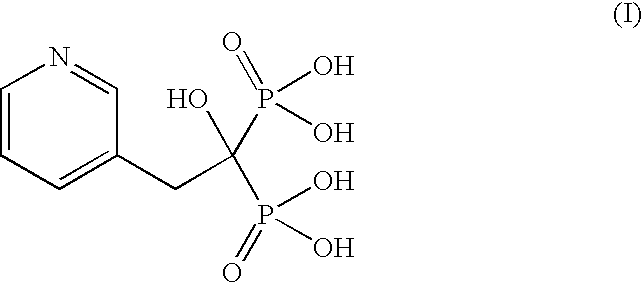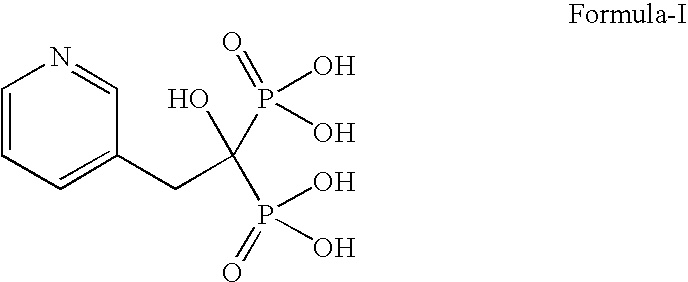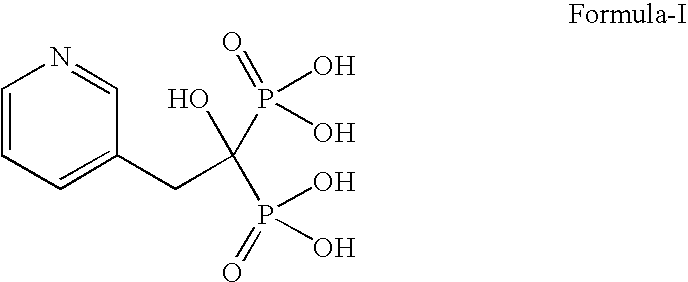Process for the preparation of pure risedronic acid or salts
a risedronic acid and salt technology, applied in the field of risedronic acid preparation, can solve the problems of inability to recycle glycols, potential toxicities, and inability to accept and be reasonable, and achieve the effect of simple layer separation method and avoidance of decantation and isolation of pure products
- Summary
- Abstract
- Description
- Claims
- Application Information
AI Technical Summary
Benefits of technology
Problems solved by technology
Method used
Image
Examples
example-1
Preparation of Risedronic Acid
[0042]3-Pyridine acetic acid (100 g) was added to acetonitrile (1.0 L). To the reaction mixture was added phosphorous acid (142 g). The reaction mass was heated up to reflux temperature (70-75° C.). To this phosphorous trichloride (271 g) was added slowly and the reaction mass was refluxed for 5.0 hours.
[0043]The solvent was distilled off completely under vacuum, Demineralized water (400 ml) was added to the reaction mass at ambient temperature and charcoalised. The filtered mass was refluxed for 4.0 hours at 85° C. The reaction mass was cooled to 0-5° C. and stirred for 2 hours. It was filtered and washed with demineralized water to get risedronic acid (175 g, yield 84.58%) as a white crystalline solid having purity of 98.59% by HPLC.
example-2
Preparation of Risedronic Acid Monosodium Salt
[0044]3-Pyridine acetic acid (100 g) added to acetonitrile (1.0 L). To the reaction mixture was added phosphorous acid (142 g). The reaction mass was heated up to reflux temperature (70-75° C.). To this phosphorous trichloride (271 g) was added slowly at 70° C. and the reaction mass was refluxed for 5.0 hours. The solvent was distilled off completely under vacuum. Demineralized water (400 ml) was added to the reaction mass at ambient temperature and charcoalised. The filtered mass was refluxed for 4.0 hours at 85° C. The reaction mass was cooled to 0-5° C. and stirred for 2 hours. It was filtered and washed with demineralized water to get risedronic acid as a white crystalline solid. The wet material was dissolved in demineralized water (300 ml) and 50% sodium hydroxide solution was added to reaction mass to make the pH basic, charcoalised and acidified with concentrated hydrochloric acid. The reaction mass was stirred further for 1.0 ho...
example-4
Preparation of Risedronic Acid Mono Sodium Salt
[0046]3-Pyridine acetic acid (25 g) was added to acetonitrile (250 ml). To the reaction mixture was added phosphorous acid (35.5 g). The reaction mass was heated up to reflux temperature (70-75° C.). To this phosphorous trichloride (58.97 g) was added slowly and the reaction mass was refluxed for 5.0 hours. The solvent was distilled off completely under vacuum. Demineralized water (100 ml) was added to the reaction mass at ambient temperature and charcoalised. The filtered mass was refluxed for 4-5 hours at 85° C. The reaction mass was cooled to 50-60° C. 50% sodium hydroxide solution was added to reaction mass to make the pH 4.2-4.5. The reaction mass was cooled to ambient temperature and then to 0-5° C. and stirred further for 2.0 hour. The solid was filtered, washed with 20% aqueous ethyl alcohol to get the pure risedronate sodium (33 g) having purity of 99.24% by HPLC.
PUM
 Login to View More
Login to View More Abstract
Description
Claims
Application Information
 Login to View More
Login to View More - R&D
- Intellectual Property
- Life Sciences
- Materials
- Tech Scout
- Unparalleled Data Quality
- Higher Quality Content
- 60% Fewer Hallucinations
Browse by: Latest US Patents, China's latest patents, Technical Efficacy Thesaurus, Application Domain, Technology Topic, Popular Technical Reports.
© 2025 PatSnap. All rights reserved.Legal|Privacy policy|Modern Slavery Act Transparency Statement|Sitemap|About US| Contact US: help@patsnap.com



